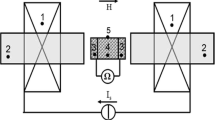Abstract
Magnetorheological fluids (MRFs) are smart materials made by base fluid, magnetizable particles, and stabilizer additives. A series of samples on varying of silicone oil, carbonyl iron particles, and oleic acid were prepared to investigate the stability of sedimentation and electrical conductivity property. Experimental results showed that the sample with mole ratio of oleic acid and carbonyl iron particles is two has the smallest saturation resistance, fastest response to external field, and the best stability of sedimentation. Further investigations suggested that low silicone oil viscosity and suitable amount carbonyl iron particles were desirable for enhance the electrical conductivity property of MRFs.





Similar content being viewed by others
References
A. Ghaffari, S.H. Hashemabadi, M. Ashtiani, A review on the simulation and modeling of magnetorheological fluids. J. Intel. Mater. Syst. Struct. 26, 881–904 (2015)
X.P. Do, S.B. Choi, High loaded mounts for vibration control using magnetorheological fluids: review of design configuration. Shock Vib. (2015). Doi:10.1155/2015/915859
M. Ashtiani, S.H. Hashemabadi, A. Ghaffari, A review on the magnetorheological fluid preparation and stabilization. J. Magn. Magn. Mater. 374, 716–730 (2015)
A.Y. Abd Fatah, S.A. Mazlan, T. Koga, H. Zamzuri, M. Zeinali, F. Imaduddin, A review of design and modeling of magnetorheological valve. Int. J. Mod. Phys. B 29, 1530004 (2015)
J. de Vicente, D.J. Klingenberg, R. Hidalgo-Alvarez, Magnetorheological fluids: a review. Soft Matter 7, 3701–3710 (2011)
S. Genc, P.P. Phule, Rheological properties of magnetorheological fluids. Smart Mater. Struct. 11, 140–146 (2002)
X.K. Wei, M. Zhu, L.M. Jia, A semi-active control suspension system for railway vehicles with magnetorheological fluid dampers. Vehicle Syst. Dyn. 54, 982–1003 (2016)
D. Case, B. Taheri, E. Richer, Dynamical modeling and experimental study of a small-scale magnetorheological damper. IEEE Asme Trans. Mechatron. 19, 1015–1024 (2014)
I. Bica, Electroconductive magnetorheological suspensions. Smart Mater. Struct. 15, N151 (2006)
I. Bica, Electrical conductivity of magnetorheological suspensions based on iron microparticles and mineral oil in alternative magnetic field. J. Ind. Eng. Chem. 12, 806–810 (2006)
I. Bica, The influence of temperature and of a longitudinal magnetic field upon the electrical conductivity of magnetorheological suspensions. Physica B 371, 145–148 (2006)
J. Vezys, E. Dragasius, V. Volkovas, A. Mystkowski, E. Korobko, The sedimentation of magneto-rheological fluid monitoring system based on resistivity measuring. Mechanika 22, 449–452 (2016)
Y.H. Huang, Y.H. Jiang, X.B. Yang, R.Z. Xu, Influence of oleic and lauric acid on the stability of magnetorheological fluids. J. Magn. 20, 317–321 (2015)
I. Bica, Giant resistances based on magnetorheological suspensions. J. Ind. Eng. Chem. 13, 299–304 (2007)
I. Bica, The influence of hydrostatic pressure and transverse magnetic field on the electric conductivity of the magnetorheological elastomers. J. Ind. Eng. Chem. 18, 483–486 (2012)
I. Bica, E.M. Anitas, L.M.E. Averis, Influence of magnetic field on dispersion and dissipation of electric field of low and medium frequencies in hybrid magnetorheological suspensions. J. Ind. Eng. Chem. 27, 334–340 (2015)
I. Bica, E.M. Anitas, M. Bunoiu, B. Vatzulik, I. Juganaru, Hybrid magnetorheological elastomer: influence of magnetic field and compression pressure on its electrical conductivity. J. Ind. Eng. Chem. 20, 3994–3999 (2014)
I. Bica, M. Balasoiu, M. Bunoiu, L. Iordaconiu, Microparticles and electroconductive magnetorheological suspensions. Rom. J. Phys. 61, 926–945 (2016)
L. Bica, Magnetorheological suspension based on mineral oil, iron and graphite micro-particles. J. Magn. Magn. Mater. 283, 335–343 (2004)
Q.X. Zhang, X.H. Liu, Y.K. Ren, L.F. Wang, Y. Hu, Effect of particle size on the wear property of magnetorheological fluid. Adv. Mater. Sci. Eng. (2016). Doi:10.1155/2016/4740986
X.H. Liu, L.F. Wang, H. Lu, D.D. Wang, Q.Q. Chen, Z.B. Wang, Effect of silicone oil viscosity on the properties of magnetorheological fluids. Optoelectron. Adv. Mater. 9, 226–230 (2015)
M.R. Morrow, J.P. Whitehead, D. Lu, Chain-length dependence of lipid bilayer properties near the liquid-crystal to gel phase-transition. Biophys. J. 63, 18–27 (1992)
M. Ashtiani, S.H. Hashemabadi, An experimental study on the effect of fatty acid chain length on the magnetorheological fluid stabilization and rheological properties. Colloid Surf. A 469, 29–35 (2015)
Y.H. Huang, Y.H. Jiang, X.B. Yang, H.Y. Sun, H.G. Piao, R.Z. Xu, Enhanced conductivity of magnetorheological fluids based on silver coated carbonyl particles. J. Mater. Sci. Mater. Electron. 27, 255–259 (2016)
X.B. Yang, Y.H. Jiang, Y.H. Huang, R.Z. Xu, H.G. Piao, G.M. Jia, X.Y. Tan, Magnetic-field-tuned insulator to conductor transition in magnetorheological suspension. J. Magn. 19, 345–348 (2014)
H.J. Choi, I.B. Jang, J.Y. Lee, A. Pich, S. Bhattacharya, H.J. Adler, Magnetorheology of synthesized core-shell structured nanoparticle. IEEE Trans. Magn. 41, 3448–3450 (2005)
N.M. Wereley, A. Chaudhuri, J.H. Yoo, S. John, S. Kotha, A. Suggs, R. Radhakrishnan, B.J. Love, T.S. Sudarshan, Bidisperse magnetorheological fluids using Fe particles at nanometer and micron scale. J. Intel. Mater. Syst. Struct. 17, 393–401 (2006)
W.Q. Jiang, Y.L. Zhang, S.H. Xuan, C.Y. Guo, X.L. Gong, Dimorphic magnetorheological fluid with improved rheological properties. J. Magn. Magn. Mater. 323, 3246–3250 (2011)
F.F. Fang, J.H. Kim, H.J. Choi, Synthesis of core-shell structured PS/Fe3O4 microbeads and their magnetorheology. Polymer 50, 2290–2293 (2009)
D. Bica, L. Vekas, M.V. Avdeev, O. Marinica, V. Socoliuc, M. Balasoiu, V.M. Garamus, Sterically stabilized water based magnetic fluids: synthesis, structure and properties. J. Magn. Magn. Mater. 311, 17–21 (2007)
X. Chen, X.Q. Zhu, Z.Y. Xu, Y.C. Lin, G.T. He, The research of the conductive mechanism and properties of magnetorheological fluids. Physica B 418, 32–35 (2013)
Acknowledgements
The work was financially supported by China Three Gorges University Talent Start-up Funds Nos. KJ2014B079 and KJ2014B080, Scientific Research Project of Yichang City No. A16-302-a14, as well as Hong Kong Research Grants Council (RGC) General Research Funds (GRF) No. CityU 11301215.
Author information
Authors and Affiliations
Corresponding authors
Rights and permissions
About this article
Cite this article
Yang, X., Huang, Y., Hou, Y. et al. An experimental study of magnetorheological fluids on electrical conductivity property. J Mater Sci: Mater Electron 28, 8130–8135 (2017). https://doi.org/10.1007/s10854-017-6519-0
Received:
Accepted:
Published:
Issue Date:
DOI: https://doi.org/10.1007/s10854-017-6519-0




